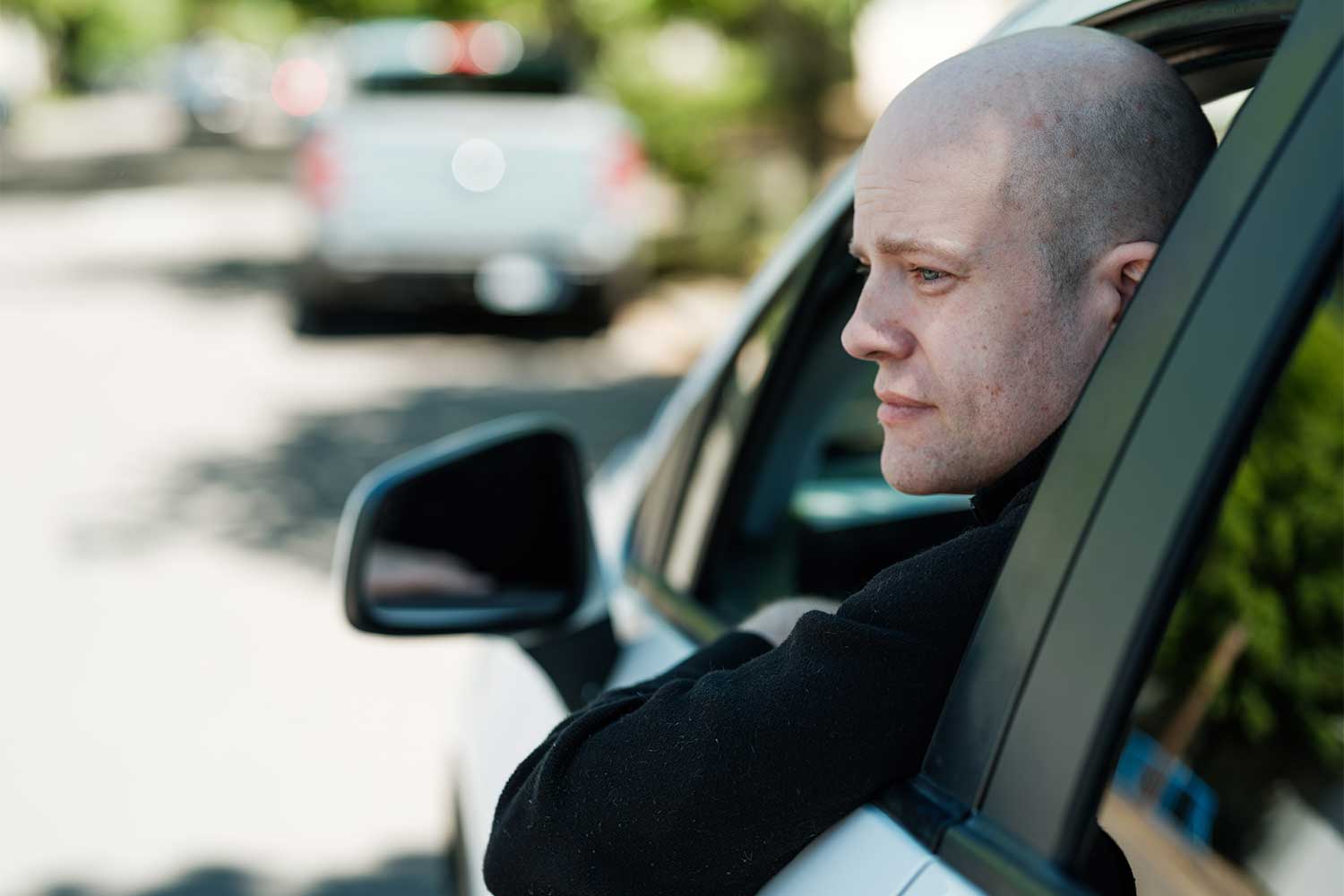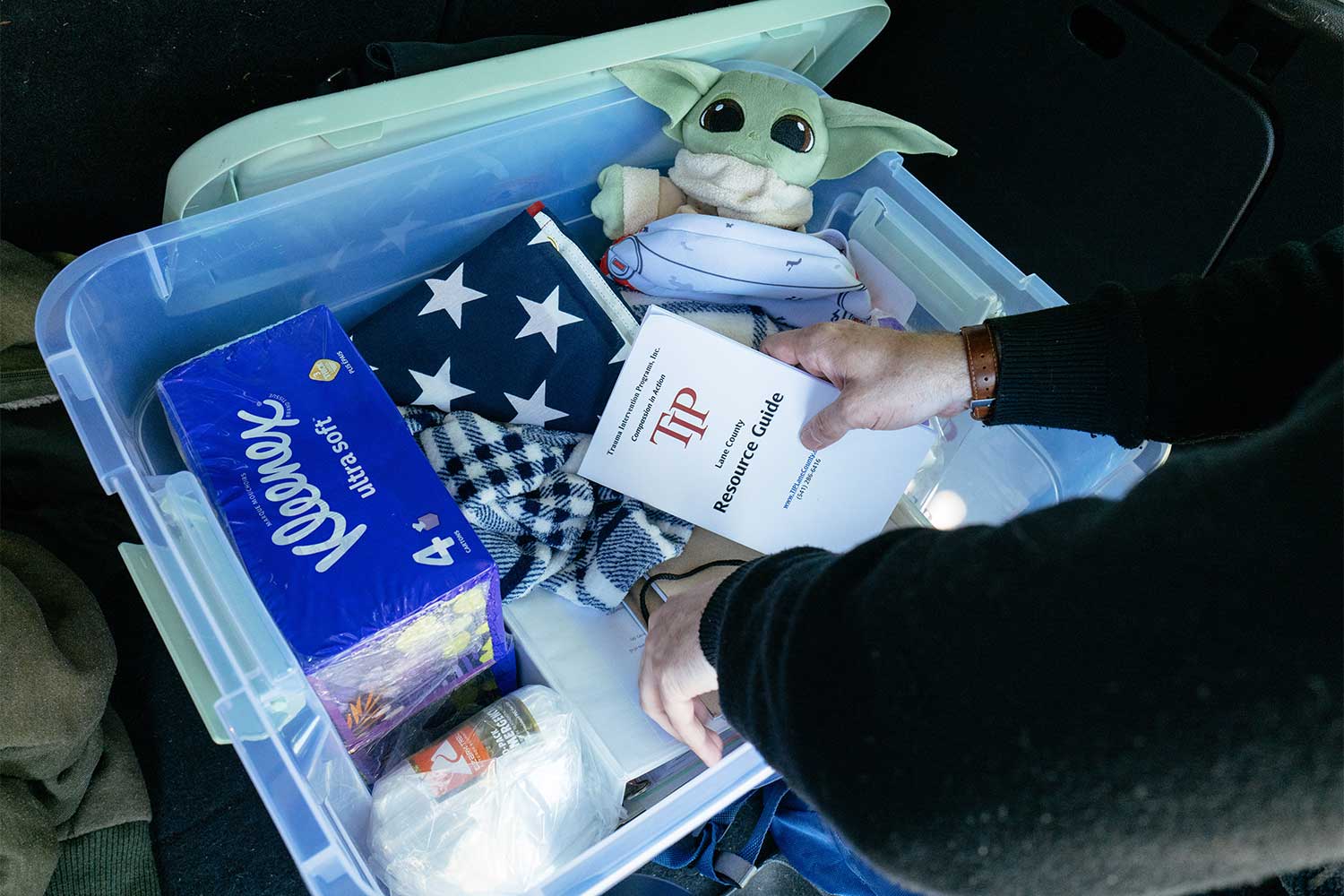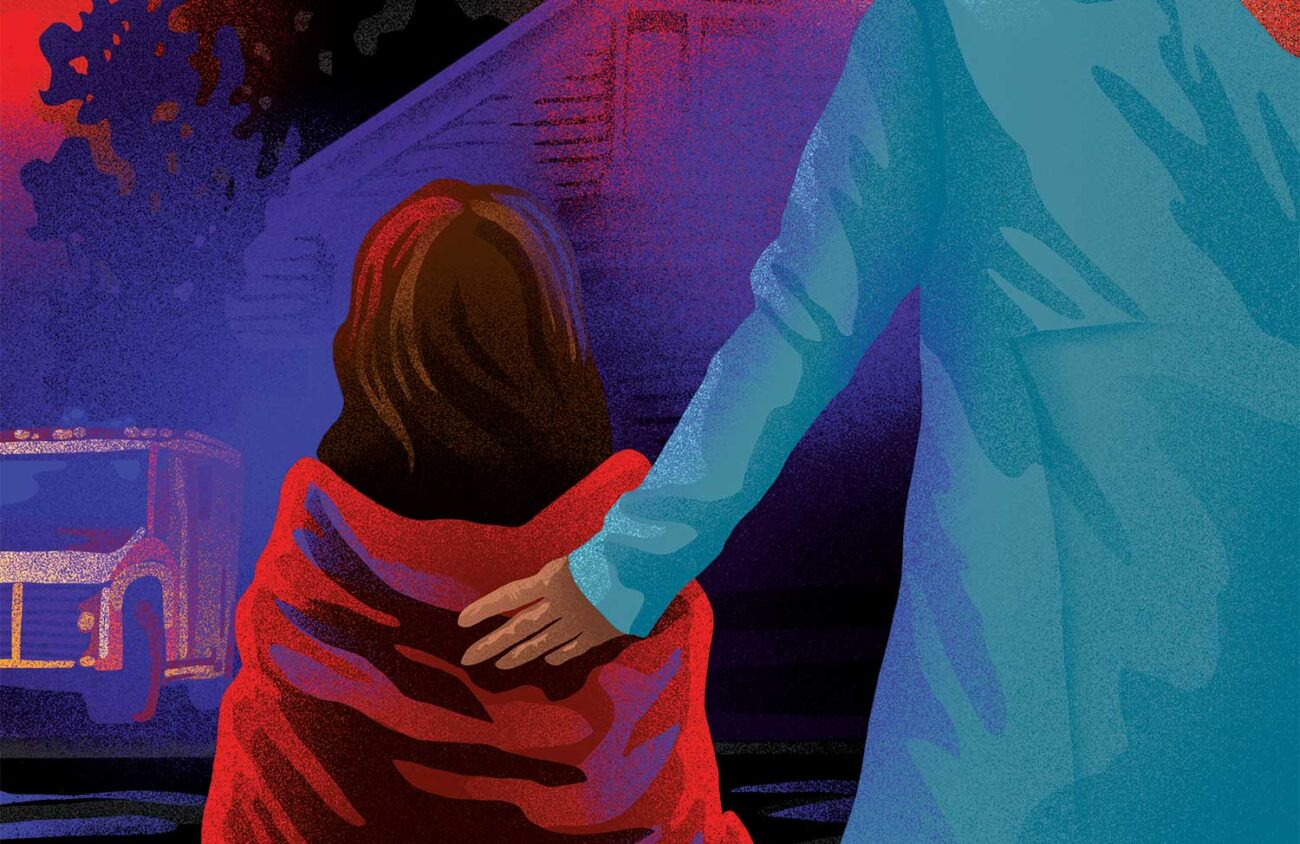On March 13, Dan Isaacson receives a call that someone jumped off a parking garage in downtown Eugene. He grabs his go-bag — a backpack with water bottles, snacks, pamphlets with counseling resources and funeral home information — gets in his car and heads to 1000 Oak Street.
Police have blocked off the streets, and lights flashed under the bridge connecting the Overpark Parking Garage. Isaacson walks over to the CAHOOTS workers who are with the family of the man who died. The distressed grandfather says he is going to go home and be with family. CAHOOTS says the mother of the deceased was the first on the scene, but she has since left.
Police gave Isaacson the names, numbers and addresses of the family as well as information for three witnesses to the death. He calls a security guard who saw the death first.
“Hi I’m Dan Isaacson, I’m a volunteer for the Trauma Intervention Program organization — TIP. We come in after a traumatic situation to provide support and listen to you. I hear you witnessed something pretty traumatizing. Would you like to talk about it?” Isaacson asks.
Isaacson is a part of TIP, a national volunteer-run service that provides immediate, on-site support to traumatized individuals 24 hours a day, seven days a week. Some of this support can include but is not limited to providing emotional support, calling family and friends for them, serving as a liaison to mental health services, and providing information on memorial services. It was implemented in Lane County in March 2023.
In addition to volunteering for TIP, Isaacson is the president of the National Alliance on Mental Illness (NAMI) Lane County, where he proposes solutions to the county for how it should be addressing mental health. He says he hopes his work at NAMI makes it so he doesn’t have to respond to as many TIP calls.
TIP responded to 124 calls in its first year. Adult suicides made up 28 of those deaths, just one death behind “unknown cause of death,” which made up 29 of the calls.
When Isaacson hangs up the phone he says he’s going to meet the security guard at the security office of the parking garage.

The security guard started working at the Overpark a year ago. He says he’s heard of these kinds of things happening at parking garages but had never experienced it firsthand. Isaacson hands him a brochure of mental health resources and asks him what he just witnessed.
He trembles but describes what he saw anyway. He ended up having to be the one to call 911.
Isaacson asks him what he was going to do tonight to take care of himself. He says after he finishes filling out this paperwork he is going to go home and play with his five-year-old kid. He points at his phone’s lock screen and says, “This guy is my everything.”
He adds while he is calm now, it comes in waves. Isaacson assures him this is a normal response and gives him his cell phone number.
“I’m going to call you tomorrow and ask how you’re doing,” Isaacson tells him.
Isaacson calls the other security guard who witnessed the event, too. He calls every family member one by one, starting with the mother, who says she needs some time and will talk to him later. He gives every witness he calls a similar message: I am here to listen to you. Some want to be left alone. Some thank him for calling. Others don’t answer at all.
“We drop in to let them know someone is here to listen,” he says. “Even if they don’t want to talk, just knowing someone is there can help.”
Isaacson goes back and forth with Eugene police, making sure they didn’t forget about any other witnesses. He asks about the police officer who witnessed the event and left shortly after. The officers assure Isaacson that a resilience team within EPD will reach out to the officer later.
Medical examiners swarm the scene, and Isaacson says it’s time to leave. He says he’s going to Tacovore. He likes to get tacos after a call as part of his own self-care.
Shortly after, Isaacson learns that the man who jumped off the building was actually a 17-year-old boy.
Later that day he calls the mom again. She wonders where her son is now. Isaacson explains that medical examiners come out for every person under the age of 18 when they die and that they are still processing the scene. From there, he would be taken to the Lane County Medical Examiners Office where she would have to decide on a funeral home for her son to go to. He says that for any person who is not the victim of the crime, the family has to decide where their loved one goes.
“That is really traumatic for people,” he says.
Isaacson talks the mother through how she was going to tell her other kid that their brother won’t be coming home tonight. He gives the family a booklet with mental health resources as well as a resource guide that shows local funeral home options.
A week later he checks in with the family again to help work out the viewing details. That was the last time he spoke to the family.
This is the seventh suicide Isaacson responded to in Lane County this year.
“My work at NAMI directly correlates with my work at TIP,” Isaacson says. “I know we aren’t doing enough for mental health in this county because I volunteer for TIP.”
Mental health professional Wayne Fortin launched TIP in 1985 in San Diego County where he spent five years working with the Oceanside Police Department, in a joint effort to try and foster a relationship between the police and mental health professionals. What he noticed in those five years of ride-alongs was that the police couldn’t manage the survivors of a traumatic event while doing their job, and mental health professionals had trouble accessing these survivors without cooperation from the police.
“We couldn’t get to survivors, and the police wanted to get rid of the survivors,” Fortin says. “TIP was really just a response to this problem.”
Fortin spent years piloting the program, figuring out how to recruit volunteers and later how to train them. The program became a nonprofit organization in 1989. TIP won a major national competition, Innovations in State and Local Government, sponsored by Harvard University and the Ford Foundation and received $100,000 to build up the organization in other cities.
Today the organization has 15 chapters across 200 cities with over 600 volunteers.
Fortin says he believes that the reason TIP has been able to be so successful over the years is because volunteers can be dispatched anywhere in their respective counties at any time. He says the average response time in Lane County is 20 minutes.
“TIP gets here remarkably fast and they’re able to assist while officers continue about their business of investigating the crime and figuring out what happened,” says Eugene Police Lt. Doug Mozan. “It’s a win-win.”
Mozan was one of the first Eugene police officers to work with a TIP volunteer after the organization launched in Lane County in March 2023. He recalls last spring 2023 when a family from Salem came to the police station looking for a loved one. Police quickly discovered that person had died in a motel in Eugene. With the help of TIP volunteers, police were able to set the family up in a hotel nearby.
“Volunteers just took it from there and it was very, very moving to see how fast the ball was rolling to help this family through their grief,” Mozan says. “It’s really unexpected, you know?”
He sees TIP as a positive asset for police officers to rely on, but he admits that not every officer was on-board at first.
Mozan explains how TIP volunteers can garner the support of his fellow officers: “Telling them, ‘Hey, it’s OK to ask for a little help in this situation because nobody expects you to be everything to everyone in every situation. These are excellent people who can help you, and they have our confidence to do that.’”
Michelle Perin, a CAHOOTS crisis worker and EMT, says that it’s exciting to see another community resource prop up in Eugene.
She adds that it’s “reassuring to know that once the acute situation has been made safe, and emergent public safety and wellness concerns are addressed by first responders like CAHOOTS, there is another community resource who can come and spend some extended time offering support.”
Multnomah County has utilized TIP for a number of years. The Portland/Vancouver chapter has more than 170 volunteers with an average of 150 calls per month.
Bridget Byfield was one of those volunteers 25 years ago and was instrumental in getting Lane County on board with TIP. She worked with police and emergency medical services to garner support for the program. She worked alongside TIP advocates such as Isaacson to get the county, Eugene and Springfield police departments, Eugene Springfield Fire and Lane County Sheriff’s Office to pay a total of $60,000 per year.
“I got a lot of pushback from people saying, ‘Why would you traumatize these volunteers?’ But we have a very strong training program and debriefing procedure after calls,” she says. “And I have seen so many volunteers say they didn’t realize how much of an impact just their presence could have on people.”
She reflects on a call she went on last summer where she sat with a woman whose brother died. A week later she called the woman to check in. “The woman said to me, ‘That day was really awful, and I will never forget that day, but I will also never forget that you were there’ — that makes it worth it.”
Byfield became the TIP program director for Lane County TIP, which Isaacson says is the first new mental health program the county has helped fund in 23 years.

“I would just like to thank every volunteer tonight,” Byfield says at the beginning of a monthly check-in she leads with TIP volunteers. “You guys have a really tough job. You have all just been above and beyond what I could dream of.”
All 45 active TIP volunteers underwent 55 hours of training, which consisted of lectures, ride-alongs, guest speakers and mentoring as well as attending mandatory meetings once a month. After a volunteer completes training they must schedule themselves for three “on-call” shifts which means for 12 hours that day they must be able to drop whatever they are doing and tend to a TIP dispatch. After the volunteers have left the scene a TIP dispatcher will call them to debrief about the call and make sure they are OK.
Isaacson says, “After a call, I will make sure I set aside some time that day to take care of myself, whether that’s making myself a nice dinner or watching a funny TV show.”
TIP doesn’t get called out to all incidents. Isaacson says that the police are in charge of dispatching TIP and they only call when they deem it is appropriate.
Byfield and Isaacson both say they want Eugene and Springfield police and the fire department to treat TIP more like “second nature,” but Byfield “understands that it takes time earning the trust and familiarity with emergency services.”
Isaacson adds, “I would much rather leave a call early because I wasn’t needed than miss a call that was crucial,” he says.
Melinda McLaughlin, EPD’s public information officer, says that TIP sometimes isn’t called in Eugene because of the rollout of a new alternative police response model, funded by the city’s Community Safety Payroll Tax, that pairs a Lane County Behavioral Health professional with a police officer to respond to calls in downtown Eugene involving people experiencing a behavioral health or life crisis.
Byfield says that TIP is currently on an annual contract with the county and all of the emergency departments they receive funding from. She adds that she’s not worried about getting funding from Lane County. “We’ve proven ourselves to the community,” she says.
In five years Isaacson hopes to see funding for the program across the state rather than just Portland and Eugene.
“Even if we just come across a call a day, that’s 365 people a year in our community who won’t have a level of trauma that they otherwise would,” Isaacson says. “What would those effects look like? What’s the impact on their families? What’s the impact on their kids, on their co-workers? On themselves?”
He says his advocacy for TIP is personal after six years ago, this July, Isaacson’s best friend, Joey Loop, was shot and killed by Lane County Sheriff’s deputies. Isaacson was left to clean up the crime scene and call his friend’s kids to tell them their dad had died.
“I had to call his kids, and they picked up the phone as their happy selves, and in my head, I’m thinking, ‘I am about to tell them the very thing that will destroy their worlds,” he says.
Isaacson says he doesn’t remember the six months before and after that day in July 2018. He doesn’t recall conversations with friends and family from that time. He has no memory of the last time he saw his best friend. He says it got so bad that people stopped telling him that he had forgotten a conversation they had because they knew what was going on.
“I had to develop a system of record keeping and notes to myself to remind myself who I talked to,” he says. He says he often wonders if someone else had been the one to clean up the scene and call the family would he still have the memories he lost.
“I am just trying to prevent anyone from experiencing what I went through,” Isaacson says.
To learn more about Lane County TIP’s services and how to volunteer go to TIPLaneCounty.org.
